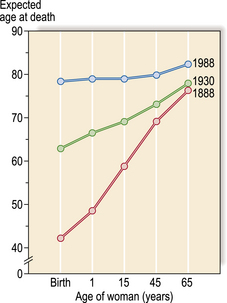Chapter 21 Changing patterns of health and illness
In the UK births and deaths are recorded by the Registrar General. The data provided on birth and death certificates are compiled by the Office of Population Censuses and Surveys, which publishes annual reports showing the incidence of disease and deaths due to specific causes and a variety of statistics relating to use of hospital and outpatient services. These reports are public documents and can be consulted in libraries and on the web.
Changes in life expectancy
Over the last century there has been a marked decline in premature death throughout the developed world. In 1888, a newborn baby girl in England and Wales had an average life expectancy of just over 40 years. By 1930, this had risen to just over 60 years, and by 1999 it had reached 80 years (Fig. 1). However, if a child survived into middle age, life expectancy even in 1888 was quite high. A 45-year-old woman in 1888 could, on average, expect to live to nearly 70 years of age, and in 1999 she had an average life expectancy of over 80 years.

Fig. 1 Average life expectancy for a woman at different ages in 1888, 1930 and 1999 (England and Wales)
(from Registrar General’s Mortality Statistics, 1999, with permission).
expectancy at birth remains below 50 years of age because of high rates of infant mortality. According to McKeown (1979), the most important factor leading to changes in infant and child mortality has been a dramatic improvement in child and maternal nutrition over the past century.





